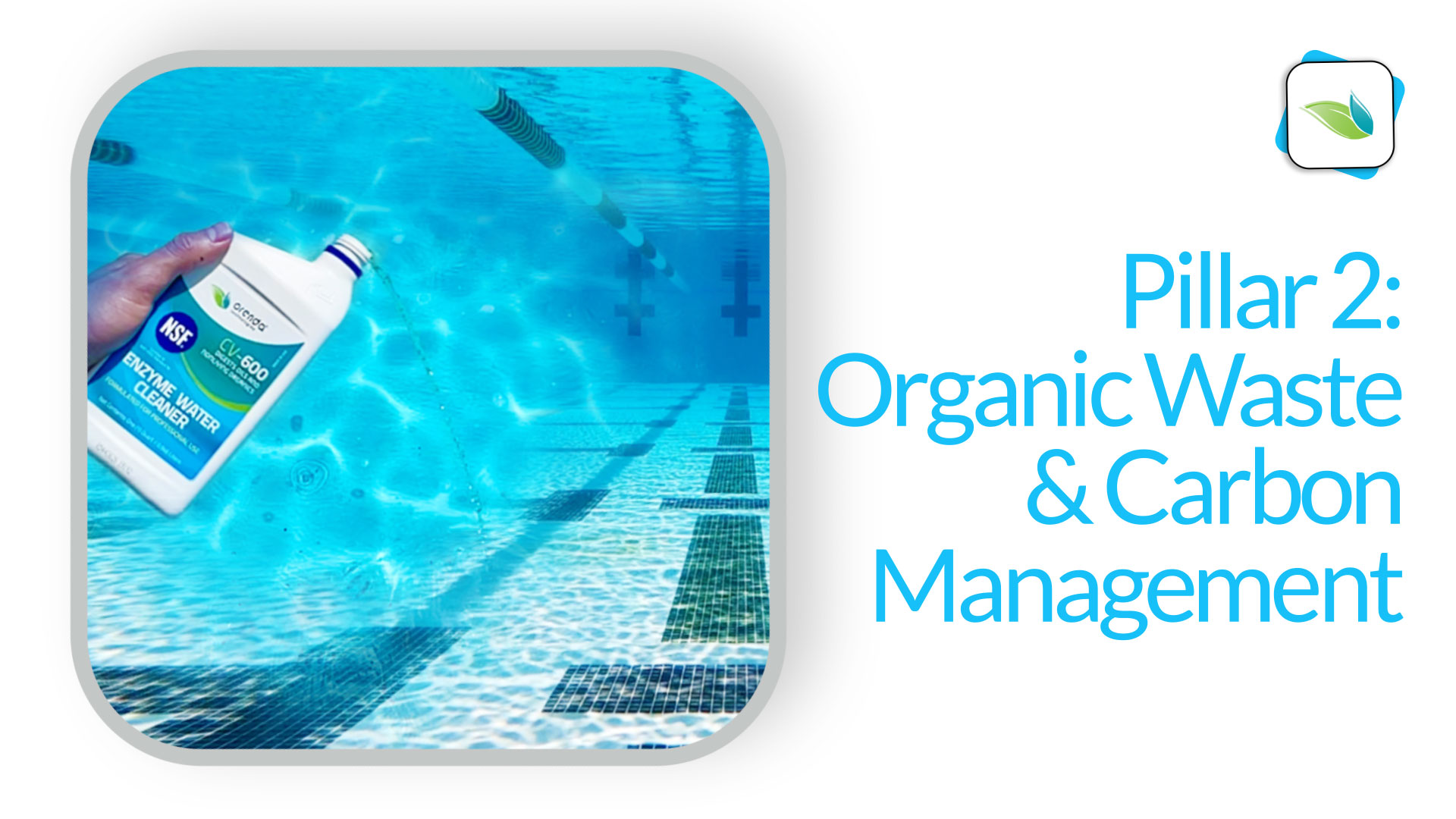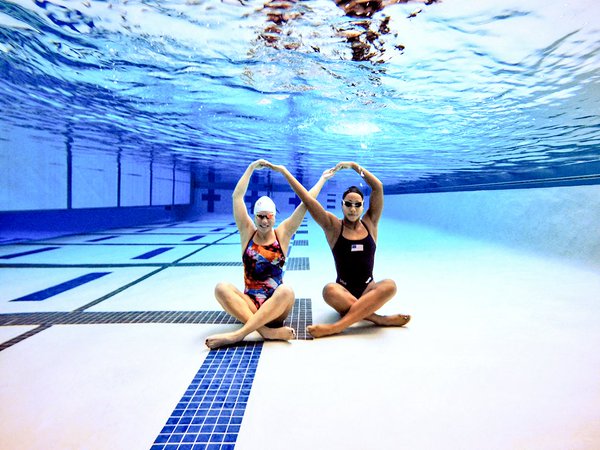Organic Waste and Carbon Management | Pillar 2

Bather waste. Non-Living Organics. Body Butter. Grease and oils. Whatever you want to call the organic waste products that contaminate swimming pools, managing them is the second of Orenda's Four Pillars. So what do we know about non-living organics? We know that swimmers and animals that use the pool leave behind oils and other carbon-based waste, and chlorine will try to oxidize these contaminants. Unfortunately, oxidation is not chlorine's specialty. Chlorine–or more specifically, the strong form of chlorine in water, Hypochlorous Acid (HOCl)–is primarily a sanitizer and disinfectant.
Action Step: Supplement chlorine with enzymes and/or secondary oxidation systems to better manage non-living organic waste.
We should start with the basics of oxidation and reduction, so you know how non-living organics are handled with chlorine alone. Then, we will focus on alternative ways to manage organic waste that do not involve chlorine itself (i.e. enzymes and secondary systems). After all, this is the second pillar of proactive pool care! This topic is about making chlorine more efficient, not using it up faster. Using chlorine alone is not proactive, it is reactive.
As usual on the Orenda blog, this article aims to simplify chemistry, so it can be more easily understood. Comment below if you want further clarification. We will also hyperlink out to some of our sources if you want to get all science-y about this. It's cool, we're nerds too.
What is Oxidation? And what is Reduction?
Oxidation is the loss of electrons by an atom, molecule, or ion. Often, the lost electrons are replaced by oxygen (but not always). Reduction is the net gain of electrons by an atom, molecule, or ion.
This means that electrons transfer from one thing to another. The rate of electron transfer can be measured in millivolts, which we in the pool business know as Oxidation Reduction Potential, or ORP. So did you catch that? Reduction is exactly the opposite of what it sounds like...it actually GAINS an electron, while oxidation is when something loses an electron. Read this to learn more about how oxidation and reduction differ from sanitation and disinfection.
Here's a video that explains how these two terms came about, and everything you ever wanted to know about redox reactions:
Should we rely on chlorine to handle organics?
Remember, we are talking about the second of Four Pillars of Proactive Pool Care. Relying solely on chlorine to oxidize organics out of the water is hardly proactive. We need a residual of free available chlorine in our water for sanitation/disinfection. If chlorine is used up oxidizing organic waste, its ability to sanitize can be affected. Think of it like this: chlorine is an excellent sanitizer and disinfectant. By comparison, chlorine is a relatively weak oxidizer. And yet, the vast majority of contaminants that chlorine attacks are non-living organics.
Furthermore, in swimming pools and hot tubs, germs and other living microorganisms like black algae (cyanobacteria) are often protected by highly-chlorine-resistant biofilms. It takes high levels and long contact times for chlorine to destroy these protective layers...if chlorine can destroy them at all.
If you had a high-performing salesperson for your company–but they were really slow with computers–would you stick them in the office most of the time to do accounting and administrative work? Hopefully not; it makes more sense to have them out doing what they do best...selling. The same holds true for chlorine. Let chlorine do what it does best...sanitize.
To be proactive, think in terms of helping chlorine handle organic waste. There are secondary systems like ozone, advanced oxidation (AOP), and hyper-dissolved oxygen (HDO) that can help a lot. And of course, there are enzymes.
Enzymes break down most organic waste
Using NSF-50 Certified enzymes like CV-600 or CV-700 on a weekly basis can to help handle the non-living organics. When you create a residual of enzymes in the water, they are out in the pool–alongside chlorine–on the front lines of bather contamination. Think about the heavily loaded commercial pools during swim meets. Orenda has treated water for some of the busiest swim meets in the country, so we know first-hand how much enzymes can help pool operators handle the extreme bather loads. For all you swimmers out there, You're probably all too familiar with cloudy water. Here's a quick video to show you what we mean:
 This is an underwater photo, without editing or filters, showing the water clarity that is possible with Enzymes.
This is an underwater photo, without editing or filters, showing the water clarity that is possible with Enzymes.
While chlorine gets used up quickly oxidizing bather waste, enzymes devour bather waste with ease. That said, enzymes are NOT any form of sanitizer, so they don't affect any living organisms. Enzymes only go after carbon-based organic waste, like body oils, sweat, lotions, sunscreen, tanning oils, cosmetics, hair products, deodorants and pet dander.
These non-living organic contaminants are the bulk of what chlorine has to address anyway. Why not let enzymes do the heavy lifting? World-class water clarity could be the result. Managing non-living organics is Orenda's second pillar of proactive pool care.
Combined Chlorine is a Nitrogen Question
We are often asked if our enzymes reduce combined chlorine. The short answer is no, enzymes do not reduce combined chlorine directly. Enzymes can dramatically reduce the organic oxidants in the water, which frees up chlorine to oxidize nitrogen compounds faster. Some customers may see a decrease in combined chlorine after using enzymes, but we think that is because chlorine is more available to address the nitrogen.
Here are some peer-reviewed scientific sources if you want to learn more about how chlorine handles nitrogen in water.
- Ammonia and Nitrogen Removal by Breakpoint Chlorination - Pressley, Bishop, Roan et. al., 1972
- Reaction Scheme for the Chlorination of Ammoniacal Water - Jafvert, Valentine et. al., 1992
- The Secrets of Breakpoint Chlorination - Anderson, Bowman, Mealy et. al.
As of now, we do not know of an enzyme in the pool business that breaks down or removes nitrogen safely. So for now, nitrogen compounds (ammonia, nitrates, etc.) must go through the breakpoint chlorination process. The process involves converting these compounds into monochloramine, then dichloramine, and eventually trichloramine. UV systems can deactivate mono- and dichloramines, which is helpful, but it is limited to what water passes through the UV chamber.
Learn more about chloramines here. And learn more about nitrates and other nitrogen compounds here.
